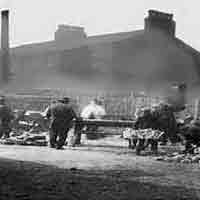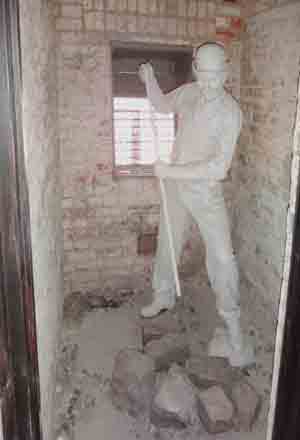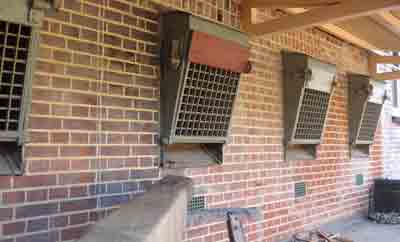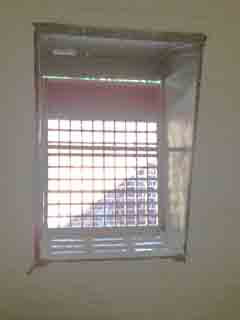Types of work required of tramps and vagrants in casual wards

This page reports on the type of work required of tramps and vagrants in return for their very meagre accommodation in casual wards. Firsthand experiences show how it was different in casual words and workhouses and that depended on the location.
____
By the webmaster based on discussions with older family and museum staff
The heavy work required by casual ward inmates?
The following photos were taken at the Guildford Spike, which has been restored as a museum on the original workhouse site. They illustrate work required of tramps and vagrants in return for their extremely inadequate one-night stay - but read on, as the first photo might not be all it seems.

Life-size model of a vagrant breaking rock in the work area at the back of his cell |

Outside the cells, showing the window grids that could be lowered on a hinge to act as sieves to check the size of the broken rocks. Photos are on this page with permission of Guildford Spike. |

Detail of inside a cell showing the grid which barred the cell and could be lowered to serve as the sieve for the broken rocks |
The photos tell the story of an inmate in the area at the back of his cell breaking rocks with some sort of spike. He has to break the rocks to such a small size that they can go through the 1½ inch grid that served as his cell window and which would have been lowered on a hinge for his work.
In practice, the rock-breaking would not have been inside the cells. It would have been done outside the cells in the yard with the other vagrants. The grid-windows would have been lowered outwards on the hinges. Clearly, the Spike museum would not want to keep their models outside, open to the elements. Hence the first photo, just to give feel of what actually happened.
Can rocks be split with a spike?
As Guildford Spike is a genuine restored casual ward on the original workhouse site, there can be no doubt that rocks did have to be broken to such a size that they would pass through the window grid and that this was accomplished with some sort of spike.
Yet can rocks be broken with a spike by men who are half starved? The answer is yes - at Guildford where the photo was taken. Guildford is on chalk and chalk is very soft, and it certainly can be broken by stabbing into it with a long-handled spike.
But what about at other casual wards where the rocks were harder?
The different work required in casual wards and workhouses and in different areas
It seems that the weak and malnourished tramps and vagrants were not, in general, given strenuous work. According to George Orwell, the work in the spikes that he knew was peeling potatoes for the meals of the inmates of the workhouse.
Yet at the Edmonton workhouse, according to my uncle's notes workhouse inmates really did have to break solid rocks for use in building roads.
So this suggests that the work required of inmates in workhouses was more strenuous than that required of inmates of casual wards. In fact, my mother claims that a very heavy hammer in her father's shed came from the workhouse. I couldn't lift it.
Probably the work of breaking stones for roads by workhouse inmates must have taken place out in a yard where there was room to wield a sledgehammer. The window grids may or may not have been lowered into to act as a sieve for the broken stones to be shovelled through.
Why were casual wards known as spikes?
Probably the worst job for casual ward inmates was the rope-teasing, which was highly unpleasant, but not physically taxing. The small spike used for this job, may have given rise to casual wards being referred to as 'spikes'.
Punishments
I was told at the Guildford Spike that if a vagrant had not broken sufficient rocks, he was not allowed to leave. Yet I can't help wondering why he would not have preferred this to having to tramp up to 20 miles or so to reach another casual ward. Do you know the answer?
| sources | webmaster | contact |
Text and images are copyright
If you can add anything to this page or provide a photo, please contact me.



